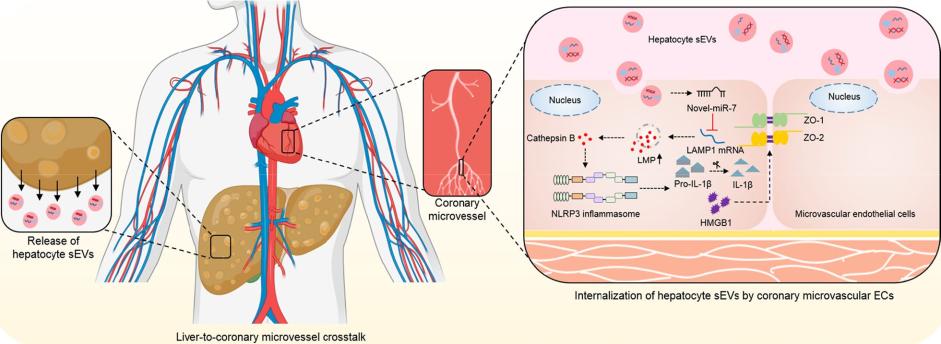Liver-Vascular Tissue Exosome Communication Research Introduction
Non-alcoholic Fatty Liver Causing Vascular Endothelial Dysfunction
With the improvement of human living standards and the increase of high-calorie diets, non-alcoholic fatty liver disease (NAFLD) has become the second most common liver disease. As a metabolic disease, NAFLD can lead to structural and functional lesions in multiple organs and systems throughout the body, including vascular endothelial dysfunction caused by the activation of various inflammatory cells including endothelial cells. Vascular endothelial dysfunction disrupts the diastolic balance of blood vessels, which can lead to increased permeability of vascular endothelium, platelet aggregation, leukocyte adhesion, and production of other cytokines, which eventually lead to cardiovascular diseases. Moreover, coronary endothelial dysfunction is more common in NAFLD patients, and the main cause of death in NAFLD patients is cardiovascular and cerebrovascular events rather than end-stage liver disease. However, the specific mechanism of NAFLD leading to vascular endothelial dysfunction has not been elucidated clearly.
Exosomes are small membrane vesicles secreted by cells. They have been shown to act as intermediaries between human tissues by delivering key messages from donor cells. Understanding the role of exosomes in liver-vascular tissue communication has the potential to improve our understanding of the relationship between NAFLD and cardiovascular disease and help improve diagnostic and therapeutic strategies for NAFLD and cardiovascular disease. Creative Biolabs has been updating its knowledge reserves and technical equipment through continuous study of the exosome communication mechanism between tissues and is willing to deepen the interpretation of the human exosome network to promote the development of human health.
Exosome Research on Liver-Vascular Tissue Communication
Based on the powerful delivery function of exosomes, exosomes may play an important regulatory role in NAFLD-induced vascular endothelial dysfunction. Therefore, Zuo et al. carried out a study on the mechanism of NAFLD-derived exosomes causing cardiac microvascular endothelial injury. They first constructed NAFLD mice by methionine choline-deficient diet induction and high-fat diet induction and extracted and identified exosomes derived from the liver tissue of these mice. Subsequent miRNA sequencing and in vitro and in vivo fatty liver exosome treating experiments revealed that cardiac microvascular endothelial injury in NAFLD mice was associated with exosomes containing novel miR-7 released by fatty liver. Further mechanistic research found that the novel miR-7 can cause lysosome rupture by interfering with LAMP1, leading to the activation of NLRP3 inflammasome in the vascular endothelium, which in turn promotes the damage of linker proteins between vascular endothelium and the subsequent enhancement of vascular permeability. These results suggest that inhibition of novel miR-7 may be a promising strategy for the treatment of NAFLD-induced cardiovascular disease.
 Fig.1 Graphical abstract of NAFLD-derived exosomes (sEVs) increasing microvascular endothelial permeability.1,2
Fig.1 Graphical abstract of NAFLD-derived exosomes (sEVs) increasing microvascular endothelial permeability.1,2
Liver-Vascular Tissue Exosome Communication Research at Creative Biolabs
The detection rate of NAFLD is increasing year by year and the patients with NAFLD are gradually getting younger. Therefore, it is urgent and important to find targets for the treatment and prevention of NAFLD and concurrent cardiovascular diseases. Since the above studies suggest that exosomes play an important role in NAFLD-induced vascular endothelial dysfunction, the study of exosome communication mechanisms between liver-vascular tissues has great diagnostic and therapeutic potential. Creative Biolabs has been focusing on providing customers with the most comprehensive tissue exosome one-stop service platform, which includes tissue exosome extraction, exosome identification, exosome profiling, exosome NGS, exosome proteomics, exosome lipidomics and metabolomics, and tissue exosome related services. If you want to study the key molecules of exosomes in liver-vascular tissue communication, please contact us now. Our professional technical team will provide you with the most efficient tissue exosome communication research solutions based on the latest research and using the most advanced equipment.
References
-
Zuo, R.; et al. Hepatic small extracellular vesicles promote microvascular endothelial hyperpermeability during NAFLD via novel-miRNA-7. Journal of Nanobiotechnology. 2021, 19(1):396.
-
under Open Access license CC BY 4.0, without modification.
For Research Use Only. Cannot be used by patients.
Related Services:

 Fig.1 Graphical abstract of NAFLD-derived exosomes (sEVs) increasing microvascular endothelial permeability.1,2
Fig.1 Graphical abstract of NAFLD-derived exosomes (sEVs) increasing microvascular endothelial permeability.1,2









